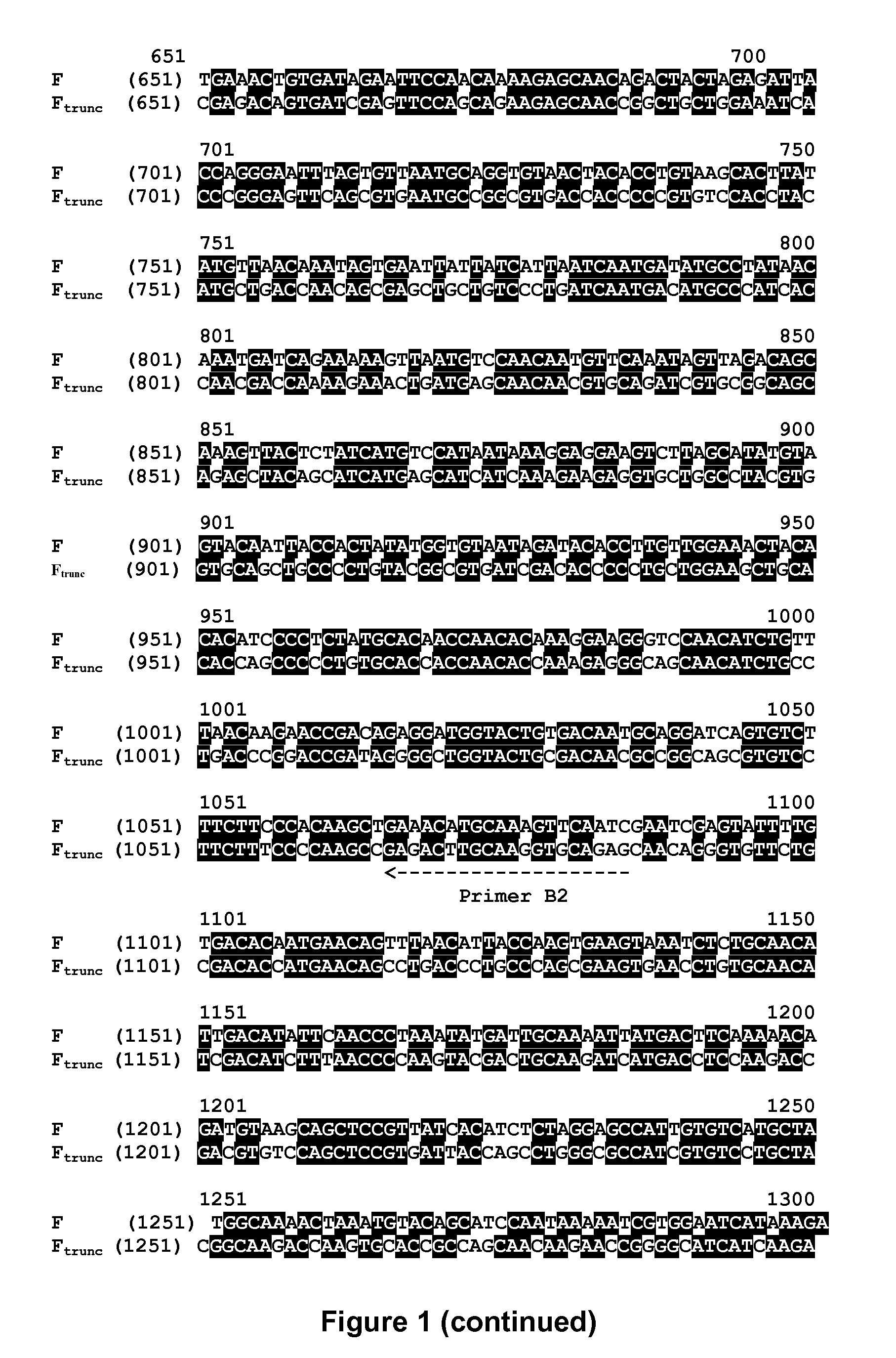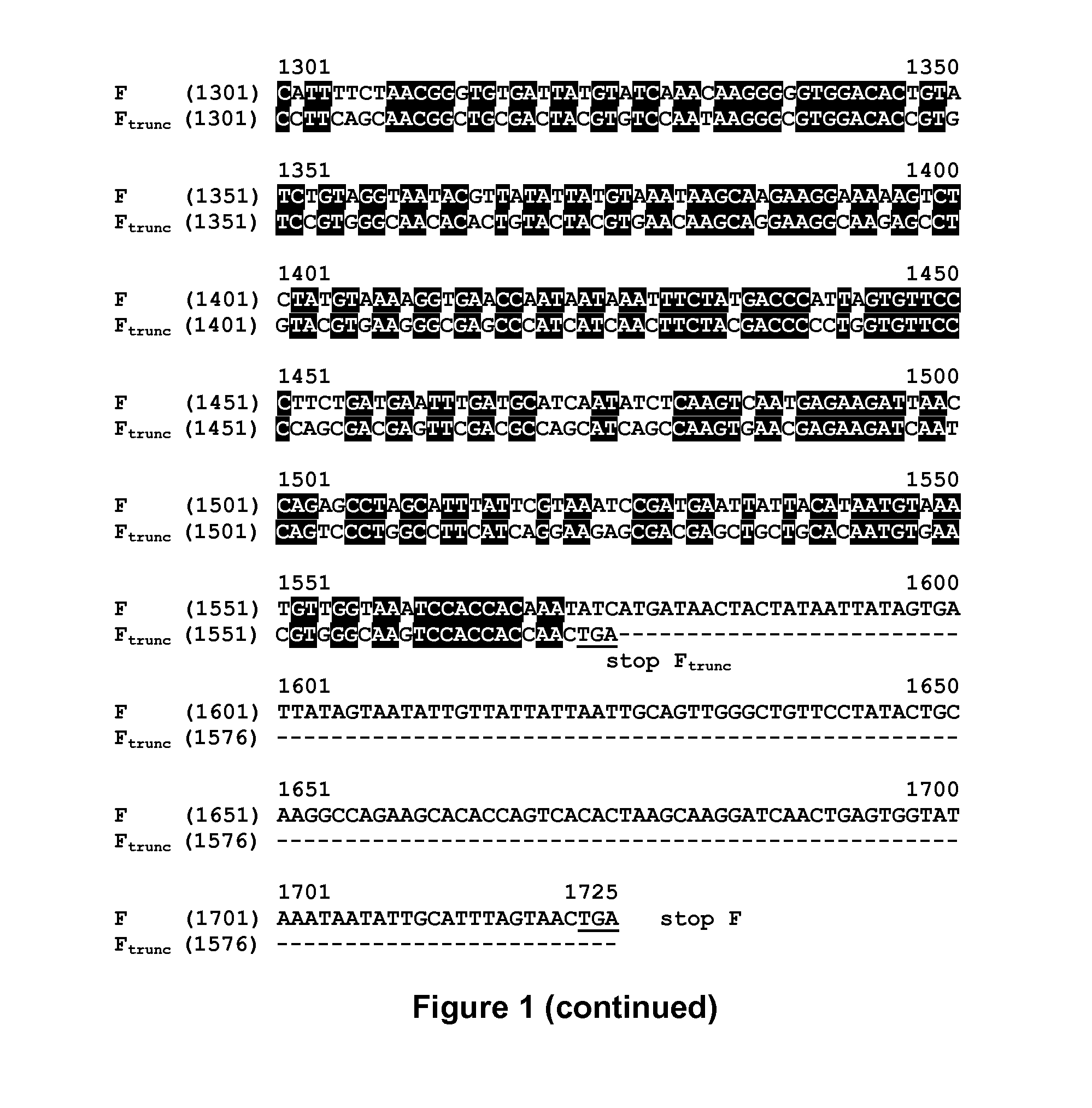Vector comprising multiple homologous nucleotide sequences
a technology of nucleotide sequences and vectors, which is applied in the field of vectors comprising multiple homologous nucleotide sequences, can solve the problems of genetic instability of tandem duplicated sequences, and achieve the effect of simplifying the purification of polypeptides and facilitating protein expression and/or purification
- Summary
- Abstract
- Description
- Claims
- Application Information
AI Technical Summary
Benefits of technology
Problems solved by technology
Method used
Image
Examples
example 1
Preparation of Substituted, Truncated F Gene
[0103]Creation of a recombinant MVA expressing both a full-length RSV-F protein and a truncated Version RSV-F_trunc was desired. However, based on results with MVA and other vaccinia viruses containing repeat sequences, it was expected that intramolecular recombination would lead to recombination between the two copies of the F gene, resulting in deletion of one of the copies of the F gene.
[0104]To minimize the presence of long stretches of identical nucleotides between the two F genes, the codons in the nucleotide sequence encoding the RSV-F_trunc gene were substituted, while maintaining the amino acid sequence of the F genes. The use of rare codons for mammals and chickens was avoided. Also, substitutions that might introduce nucleic acid signals were avoided. Such signals included internal TATA-boxes, chi-sites, and ribosomal entry sites; AT-rich and GC-rich sequence stretches; ARE, INS, and CRS sequence elements; repeat sequences and R...
example 2
Preparation of Recombinant Viruses Comprising RSV-F Genes
[0105]The DNA encoding the full-length RSV-F gene was inserted into MVA at two different integration sites to generate MVA-mBN170B and MVA-mBN172B (in the IGR88 / 89 site). The substituted, RSV-F_trunc gene was inserted into MVA at the IGR148 / 149 site to generate MVA-mBN173B.
[0106]A double recombinant MVA was then created containing the full-length RSV-F gene inserted into MVA at the IGR88 / 89 site and the substituted, RSV-F_trunc gene inserted into the same MVA at the IGR148 / 149 site. The double recombinant virus was called MVA-mBN175B. A schematic of this virus is shown in FIG. 4B.
example 3
[0107]Expression of F Proteins from Recombinant Viruses To determine whether protein was expressed from the substituted nucleotide sequence, western blot analysis was performed on protein extracts from a human cell line infected with a recombinant MVA-BN®-based virus encoding the full-length RSV-F gene (MVA-mBN172B), the virus encoding the substituted, RSV-F_trunc gene (MVA-mBN173B) and a double recombinant virus encoding both, the full length and the RSV-F_trunc gene (MVA-mBN175B). All three viruses showed the production of the appropriately sized RSV-F proteins by Western blot analysis (FIG. 3), while the MVA-BN® control (empty vector) did not show any bands, as expected. Thus, the full length and the truncated F protein expressed from the substituted coding nucleotide sequence were expressed individually from single recombinant MVA-BN® but both were also co-expressed from one double recombinant MVA-BN® virus (MVA-mBN175B) in a human cell line.
PUM
| Property | Measurement | Unit |
|---|---|---|
| Fraction | aaaaa | aaaaa |
| Fraction | aaaaa | aaaaa |
| Fraction | aaaaa | aaaaa |
Abstract
Description
Claims
Application Information
 Login to View More
Login to View More - R&D
- Intellectual Property
- Life Sciences
- Materials
- Tech Scout
- Unparalleled Data Quality
- Higher Quality Content
- 60% Fewer Hallucinations
Browse by: Latest US Patents, China's latest patents, Technical Efficacy Thesaurus, Application Domain, Technology Topic, Popular Technical Reports.
© 2025 PatSnap. All rights reserved.Legal|Privacy policy|Modern Slavery Act Transparency Statement|Sitemap|About US| Contact US: help@patsnap.com



